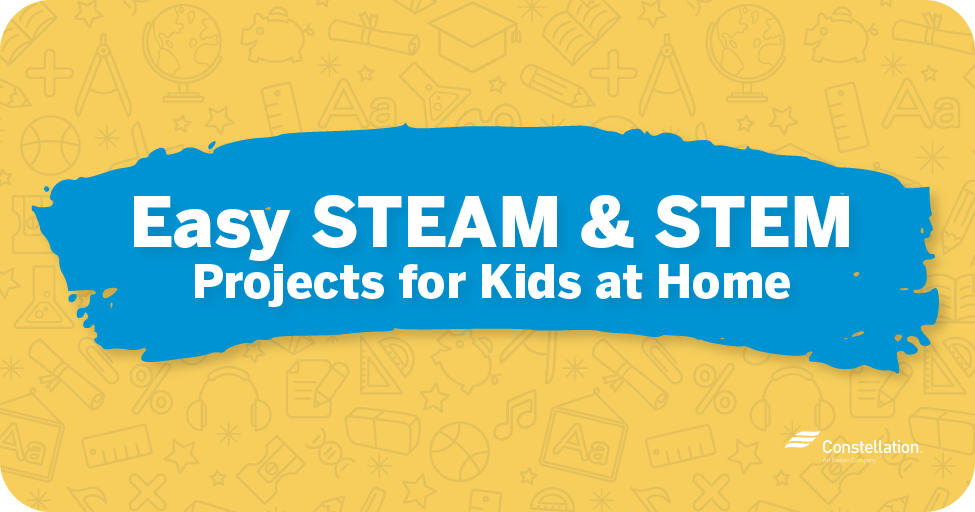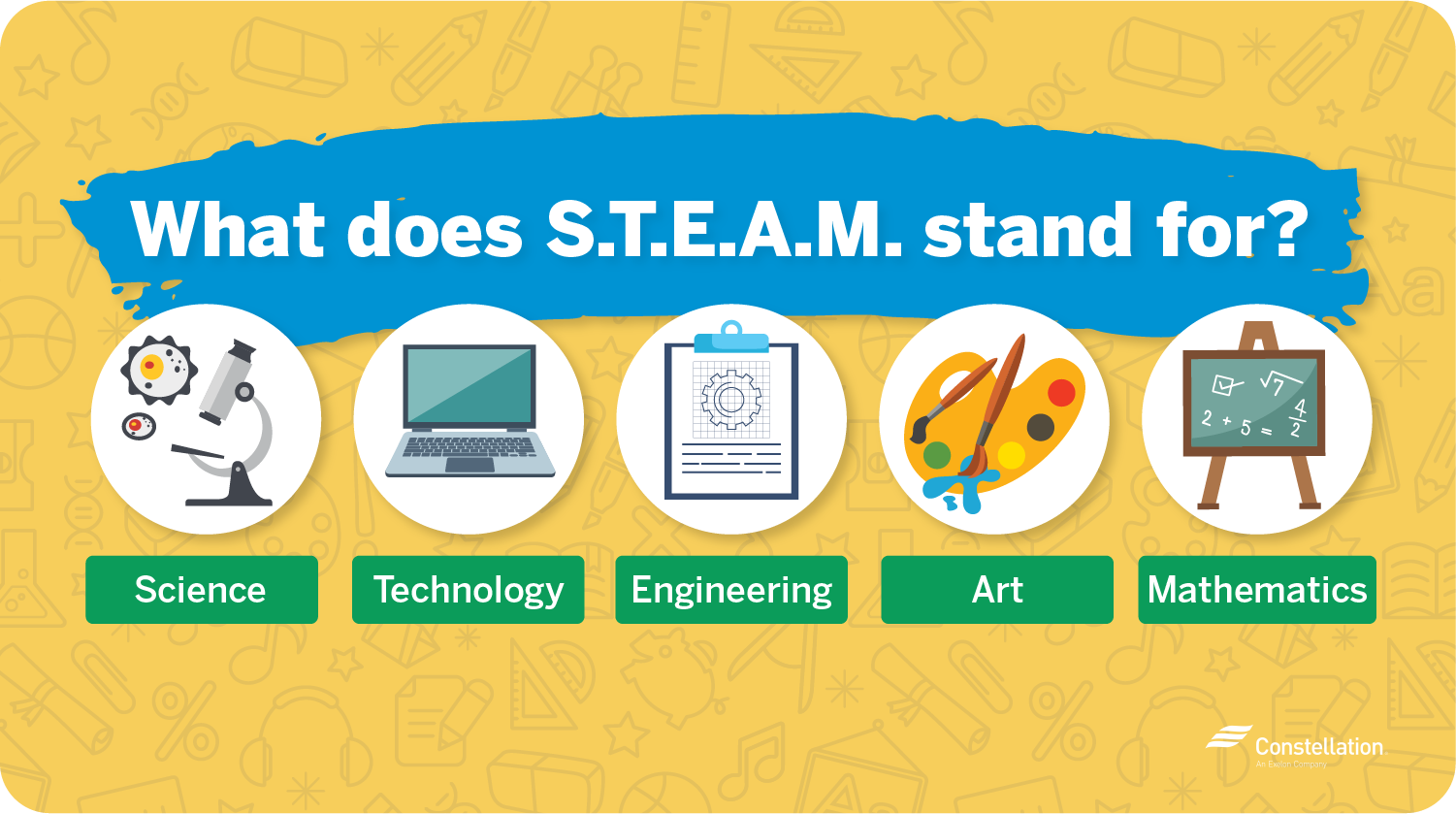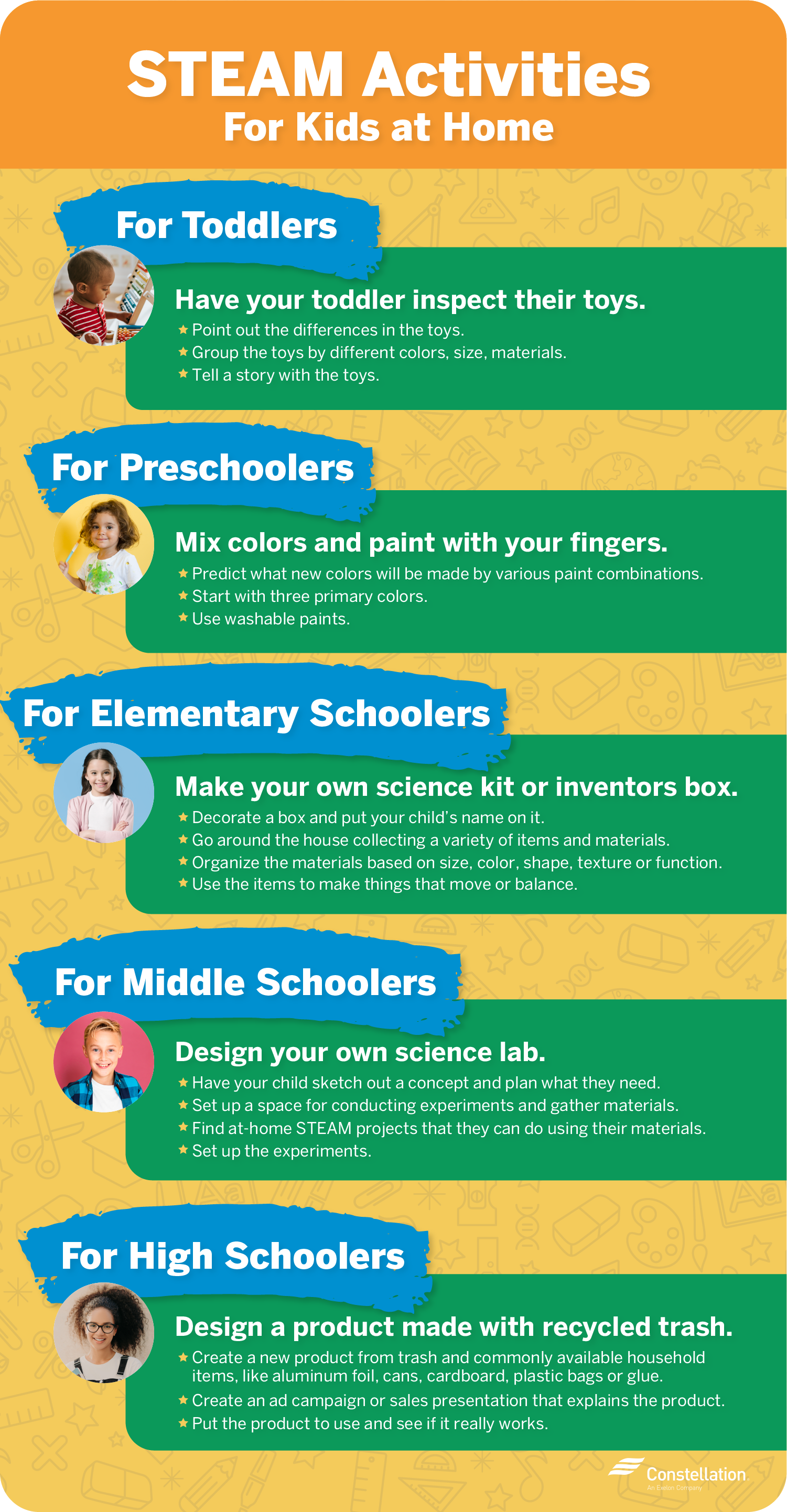
- Category:
Lifestyle -
Last updated:
January 19, 2022
Easy STEAM & STEM Projects for Kids at Home
Home STEM projects and STEAM activities are effective ways to help your children learn and have fun. STEM is an acronym for science, technology, engineering and math. Add an “A” for “art” and it becomes STEAM. Both acronyms refer to learning that’s logical, evidence-based, practical and creative. These skills are vital for many high-earning jobs of tomorrow.
What are STEAM activities and how can they benefit your kids?

STEAM stands for science, technology, engineering, art and math. The idea builds on the STEM intelligence and skills by adding a creative element to STEAM activities. Exposure to art and creativity encourages innovative and imaginative thinking. Kids benefit from sensory exploration, use of symbols, playacting and pattern recognition that artistic development brings.
What’s the difference between STEM and STEAM projects?
STEM activities help children to understand the natural world through observation and testing, to learn to use tools and technology to accomplish tasks, to figure out how things work and to solve problems with logic and measurement. STEAM projects include a creative approach to STEM education. By engaging both sides of the brain at once, students learn to combine several disciplines and better solve new problems.
Where science meets art: STEAM projects for kids at home
STEAM activities for kids at home blend scientific thinking with creative thinking. These home STEAM projects are fun. But they also encourage learning and lead to cognitive development. And they’re an enjoyable way to spend time with your children!

1. STEAM activities for toddlers at home
These STEAM ideas for kids are appropriate for younger children. Children just beginning to talk enjoy discovering, experimenting and creating.
Recommended activity: Have your toddler inspect their toys
- Children love their toys and love to talk to you about them. Ask them about how toys are different: Some move and others don’t; some make sound, and some are silent; some have wheels; and some are people or animals.
- Ask your toddler to sort toys by color, size, material and type. The possibilities are endless.
- Play with different combinations of toys to build things or tell stories. It might be fun to create an imaginary world with all the toys.
Additional activities for toddlers:
- Let’s Talk, Read and Sing About STEM — This is a teacher and parent guide to STEM projects for kids. It’s full of additional STEM and STEAM activities you can try.
2. STEAM activities for preschoolers at home
By the time your child is in preschool, they’re ready for more challenging home STEAM projects.
Recommended activity: Mix your own colors and paint with your fingers
- Kids love to get their hands into finger paints. Try to create new colors together, guessing how adding two colors together might come out.
- Start with three primary colors to stimulate mixing creativity.
- Finger paints are messy, but you can find ones that wash up easily.
Additional activities for preschoolers:
- Dance Party — Burn some energy and encourage confident self-expression with dance party games you can do with your child.
- What Happened to the Egg? — Eggs are more than just food. You can guess and watch what happens to this organic material over time.
- Let’s Pretend: Learning Through Dramatic Play — Encourage language development, self-expression and self-esteem with these playacting games.
3. STEAM activities for elementary schoolers at home
School-age children can take on more involved STEAM projects and STEM activities at home.
Recommended activity: Make your own science kit or inventor’s box
- Have fun and stimulate creativity by having your child decorate a box and put their name on it.
- Go around the house collecting a variety of items and materials like paper towel tubes, tissue paper, straws, paper clips, marbles, coins, aluminum foil and wire.
- Organize the materials based on size, color, shape, texture or function.
- Use the items to make things that move or balance. See just how inventive your child can be, assisting with glue, staples and tape.
Additional activities for elementary schoolers:
- Create Your Own Accidental Art — Make art a creative conversation. And you don’t have to be good at drawing to enjoy this STEAM activity.
- From Seed to Fruit — Watching a tiny seed sprout and grow is magical. This activity also teaches responsibility and caring for a living thing.
- Design Your Own Plant Superhero — Plants do more than you think. Help your child understand how plants clean the air in this fun STEM idea for kids.
- Habitat Mapping Game — This STEM project for kids gets them thinking about how animals live in the wild and how habitats support them.
4. STEAM activities for middle schoolers at home
Older children can complete sophisticated STEAM activities at home that foster a genuine sense of achievement.
Recommended activity: Design your own science lab
- Have your kid plan and design their own lab.
- Start by having them sketch out a concept and plan what they might need.
- Next, they’ll set up a space for conducting experiments and gather materials from around your home.
- Encourage your child to research at-home STEM projects that they can do using commonly available materials. Then have them set up the experiments.
- Get started using the lab and adding to it.
Additional activities for middle schoolers:
- Food Chains/Food Webs — In this home STEM activity, your child will learn about how plants and animals play different parts in the food chain in diverse environments.
- Kandinsky Experiment: The Majesty of Music and Math — In this STEAM activity for kids, they use drawing gestures to create music and visual art together.
5. STEAM activities for high schoolers at home
High schoolers can conduct serious scientific experiments that validate important scientific theories and mathematical formulas — all with household items — for fascinating home STEAM projects.
Recommended activity: Design a functional product made with recycled trash
- Develop an engineering mind and the ability to innovate by creating a new product from trash and commonly available household items. These might include aluminum foil, bottles, cans, cardboard boxes, plastic bags, staples, tape or glue.
- Create an ad campaign or sales presentation that explains the features and benefits.
- Put the product to use and see if it really works.
- This home STEM activity reinforces the value of recycling and develops presentation skills too.
Additional activities for high school students
- Thermal Energy Transfer — Your teen can explore the laws of thermodynamics and how they affect cooking, heating and cooling a home, and weather.
- Build a Cleaner Battery — This activity helps your teenager understand what’s at work in batteries powering cell phones and other vital devices.
- Magnetic Microbot Models — This home STEAM project involves building a magnet-powered robot.
Doing STEM and STEAM activities for kids at home reinforces and expands on what they learn at school. These creative STEAM activities also give parents something fun to offer their kids as an alternative to screen time. More than ever, parents are looking for creative ways to engage their children and possibly limit time on their devices. With these STEAM experiments for kids, you can do that and build the skills they’ll need for the future.




